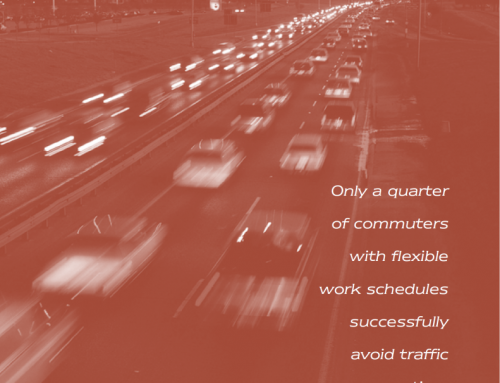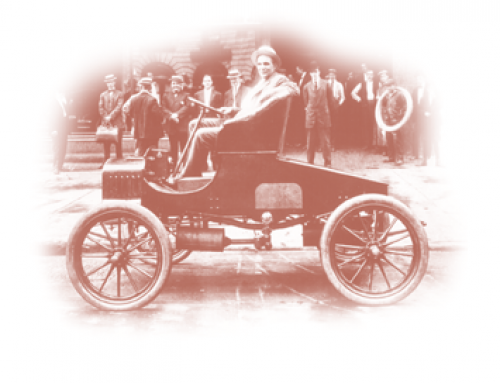[sharelines]Goods movement policies must consider both small private operators and large trucking companies.
Trucks play critically important roles in the US economy. Measured by its value, nearly seventy percent of freight is carried exclusively by truck while another eighteen percent spends at least part of its journey on the road. For most motorists, traffic congestion is a nuisance; for truckers, it can be crippling. If truckers are inconvenienced, costs rise for everyone. The strength of each region’s industrial base depends on the ability of freight-transport companies to provide swift and reliable goods movement at tolerable costs. In addition, trucks caught in traffic congestion generate significant negative externalities including pollution, lost productivity, accident costs, and stress.
 Truckers are well-informed on the workings and failings of the US transportation system, and also are major political actors, constituting a powerful lobby on issues that affect their industry. Both their level of concern about the issue of congestion and their expertise on the ground give policymakers plenty of reason to seek their opinions on the subject, asking which policies truckers would be likely to support.
Truckers are well-informed on the workings and failings of the US transportation system, and also are major political actors, constituting a powerful lobby on issues that affect their industry. Both their level of concern about the issue of congestion and their expertise on the ground give policymakers plenty of reason to seek their opinions on the subject, asking which policies truckers would be likely to support.
In an effort to discover how they judge various congestion-mitigation strategies proposed by traffic managers, analysts, and researchers, we conducted a study that just asked them. The trucking industry is diverse, not only in terms of sizes of companies but in the parts of the freight trip they handle and how they handle it. So to understand why they prefer certain policies over others, we first had to learn how trucking companies function.
We soon found some consistent links between types of trucking operations and truckers’ opinions. It proved useful to identify these links because it allows us to see which truckers prefer which policies. With this information, government investments needn’t favor one segment of the industry over another.
We also found that the industry is changing at a rapid clip. Historically the freight industry has changed slowly, but with the emergence of e-commerce, new information technologies, and advanced traveler information systems, trucking is undergoing a profound transformation.
For most motorists, traffic congestion is a nuisance; for truckers, it can be crippling.
Diversity of Operations
The trucking industry is already highly diverse. It includes companies with several thousand vehicles as well as owner operators who lease, own, or control only a single vehicle. Private fleets, typically under the control of a large company, account for a large portion of the industry. Some trucking companies move full containers or truckloads exclusively, while others move smaller shipments or manage networks of consolidation and distribution facilities. At the extreme, companies like UPS and FedEx move exclusively small shipments through vast networks and hubs.
Some companies provide specialized services, like moving refrigerated goods. Others manage fleets of tank trucks carrying various liquids. Others move high-value, expedited, or hazardous loads. Some, known as dray carriers or drayers, focus on short moves as part of intermodal operations—that is, operations involving ground-and-sea or road-and-rail operations. Other truckers focus on ground moves associated with air cargo operations. Companies may be engaged in local, regional, national, or international traffic. Some companies have long lead times (the time between requests for service and the time when delivery is required), while others primarily react to requests within several hours.
Truckload carriers move whole containers only, while less-than-truckload (LTL) carriers contract shipments of any size. Private carriers are typically part of a larger company, such as a grocery chain, while for-hire carriers simply provide transportation or both transportation and logistical services. For-hire carriers may be contract carriers, working under contract with one or more customers, or common carriers, available to serve any customer. Tank and refrigerated carriers have specialized fleets and high operating costs. Household movers have rather long loading and unloading times relative to other carriers and typically make final deliveries with the help of at least one driver who is familiar with the deliver y area. Bulk carriers move high-volume, low-value goods.
The Changing Industry
Current industry changes are being driven by emerging e-commerce and related information technologies, including advanced traveler information services (ATIS) aimed specifically at commercial vehicle operators.
E-commerce is generating many changes in the industry. Some trucking companies are becoming full-service providers, managing warehouses, distribution channels, and in some cases even final assembly of goods. Others are taking advantage of on-line load-matching services, making  it easier for small carriers and independent owner operators to find loads on a day-to-day basis. (These load-matching services may be fee-based or free. Some are managed by large trucking companies or consortia of trucking companies, who find it profitable to contract practically all loads that come their way but then subcontract unprofitable or excess loads to small carriers on a load-by-load basis. Others are simply web sites supported by modest fees or advertising.) In addition, niche carriers are emerging to support local same-day or next-day deliver y of goods required by “e-tailers,” most of whom are not equipped to provide distribution services.
it easier for small carriers and independent owner operators to find loads on a day-to-day basis. (These load-matching services may be fee-based or free. Some are managed by large trucking companies or consortia of trucking companies, who find it profitable to contract practically all loads that come their way but then subcontract unprofitable or excess loads to small carriers on a load-by-load basis. Others are simply web sites supported by modest fees or advertising.) In addition, niche carriers are emerging to support local same-day or next-day deliver y of goods required by “e-tailers,” most of whom are not equipped to provide distribution services.
Information technology for commercial vehicle operators aimed at making travel safer and more efficient includes many commercial software packages. Examples include routing and scheduling optimization, fleet location and status monitoring, container management, marginal and average cost modeling and freight rating, and ATIS, which may be publicly or privately financed and managed. Automated message signs are an example of publicly developed ATIS. Automated weigh/inspection station bypass systems have been developed by public/private sector partnerships. More and more private ATIS technologies are being bundled with commercial communications and software packages.
The Study
We wanted to understand the relationships between the characteristics of trucking firms and the policy measures they favor. We looked at many different characteristics, such as truckload vs. less-than-truckload (LTL), private vs. for-hire, contract vs. common carrier. We identified the primary service provided by these companies (general truckload, general LTL, tank carrier, refrigerated carrier, household mover, bulk carrier), and the types of services provided (all of the above plus high-value, just-in-time, rail, air and maritime intermodal, and hazardous materials movements).
Our survey asked truckers about alternative policies for mitigating congestion, essentially six strategies: (1) new dedicated truck facilities, (2) improved operations, (3) improved traffic management, (4) enhanced priority for trucks in urban settings, (5) increased road capacity, and (6) congestion tolls.
Class One: Dedicated Truck Facilities
This class includes special arterial lanes for trucks, special freeway lanes for trucks, and dedicated truck streets. In general, the larger the firm, the more likely it is to oppose this group of remedies. That’s so because large companies make a high proportion of long distance journeys, so their drivers do not spend a lot of their time in congested urban areas, whereas small companies are likely to operate largely in town. The trucking firms that support these policies are typically the users of intermodal rail and maritime facilities, common carriers, and operators engaged in just-in-time deliveries.
Class Two: Improvements in Operating Efficiency
Such remedies would reduce waiting time at ports and distribution centers, speed vehicle clearance at weigh stations and border crossings, and create truck-only streets for access to ports and rail terminals. Some of these policies are already being implemented. Weigh stations and border  crossings are moving quickly towards advanced vehicle clearance systems. Truck-only streets might have sounded unlikely a few years ago, but implementation of the Alameda corridor at the busy ports of Los Angeles and Long Beach suggest that large cooperative private/public projects are possible. Such investment naturally has the support of the system’s users and may be an attractive option for other severely congested freight hubs. This class of policies is supported by users of all three types of intermodal facilities (rail, air, and maritime), by those engaged in long-haul operations, and by truckload carriers. Private fleets, on the other hand, are not as interested.
crossings are moving quickly towards advanced vehicle clearance systems. Truck-only streets might have sounded unlikely a few years ago, but implementation of the Alameda corridor at the busy ports of Los Angeles and Long Beach suggest that large cooperative private/public projects are possible. Such investment naturally has the support of the system’s users and may be an attractive option for other severely congested freight hubs. This class of policies is supported by users of all three types of intermodal facilities (rail, air, and maritime), by those engaged in long-haul operations, and by truckload carriers. Private fleets, on the other hand, are not as interested.
Class Three: Improvements in Traffic Management
Policies that fit freight-industry perceptions of improved traffic management include, first and foremost, traffic-signal optimization, followed by electronic pre-clearance systems at checkpoints, parking bans on some streets, and a database that tracks hazardous materials loads (for use in clearing accidents). LTL operators, and small operators in general, hold the most positive attitudes toward this class of traffic-management policies; but contract carriers and truckload operators don’t favor them. Contract carriers tend to work established, familiar routes, relying on experience and familiarity to negotiate traffic congestion; truckload carriers tend to spend most of their time on relatively less-congested highways.
Class Four: Priority for Trucks on Urban Sterets
Truck priority schemes include those allowing trucks to preempt certain traffic signals, eliminating on-street parking during certain periods, and dedicating arterial lanes to truck-only traffic. Common carriers, long-haul operators, and household movers prefer this class of policies. Household movers in particular, who regularly negotiate unfamiliar residential neighborhoods and for whom parking may be extremely difficult, stand to gain from reduced urban congestion and competition for parking.
Class Five: Increased Road Capacity
Operators with short hauls strongly favor strategies that increase road capacity, while long haulers do not. LTL operators and household movers are somewhat in favor of such strategies while private fleet, truckload, and tank operators are not. Short haulers tend to spend much of their time near urban areas or between maritime ports and railheads; and, in California and indeed in most states, the areas around major ports are seriously congested. Long haulers tend to spend more time on the open road.
Class Six: Congestion Tolls
Congestion pricing, in the form of peak-hour tolls, has some support from carriers who provide just-in-time pickups and deliveries, those with short hauls and average loads, and household goods movers. Private fleets do not favor congestion pricing.
Truckers are well- informed on the workings and failings of the US transportation system, and a powerful lobby on issues that affect them.
Implications
By concentrating on three classes of policy—those related to improved traffic management, truck priority, and better operational efficiency at truck facilities— planners can implement strategies promising to appeal to all industry segments. The first two seem to be most cost-effective, and all three groups can be implemented in small pieces and targeted to severely congested places. Our study elicits preferences from across the entire spectrum of the industry, allowing smaller companies to have more of a voice than they otherwise would. With this information, policy makers can choose investments that benefit large segments of the industry without favoring the most vocal sector at the expense of those without as much political muscle.
Further Readings
David A. Hensher and Tom F. Golob, “Searching for Policy Priorities in the Formulation of a Freight Transport Strategy: A Canonical Correlation Analysis of Freight Industry Attitudes Towards Policy Initiatives,” Transportation Research Part E, Logistics and Transport Review, v. 35, no. 4, pp. 241-267, 1998.
Tom F. Golob and Amelia C. Regan, “Freight Industry Attitudes Towards Policies to Reduce Congestion,” Transportation Research Part E , Logistics and Transportation Review, v. 36, no. 1, pp. 55-77, 1999.
Amelia C. Regan and Tom F. Golob, “Maritime Intermodal Trucking Operations in California: Industry Perceptions of Congestion Problems and Potential Solutions,” Transportation Research Part A, Policy and Practice, v. 34, no. 8, pp. 587-605, 2000.
Tom F. Golob and Amelia C. Regan, “Impacts of Highway Congestion on Freight Operations: Perceptions of Industry Managers,” Transportation Research Part A, Policy and Practice, forthcoming.
Tom F. Golob and Amelia C. Regan, “Trucking Industry Demand for Information Technologies: A Multivariate Discrete Choice Model,” Transportation Research, Part C, Emerging Technologies, forthcoming.









